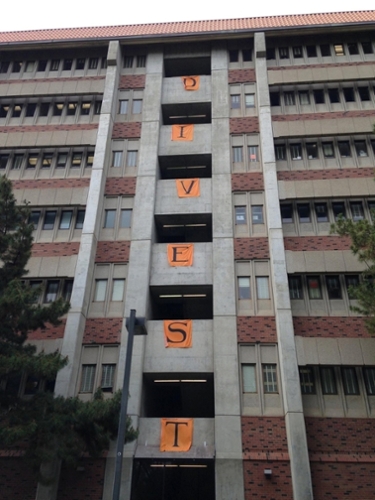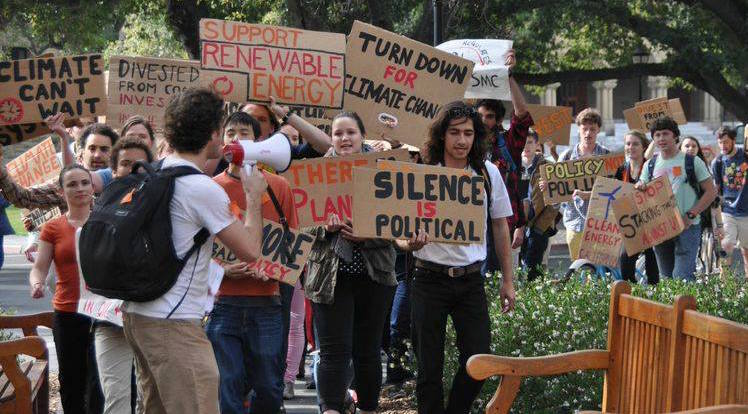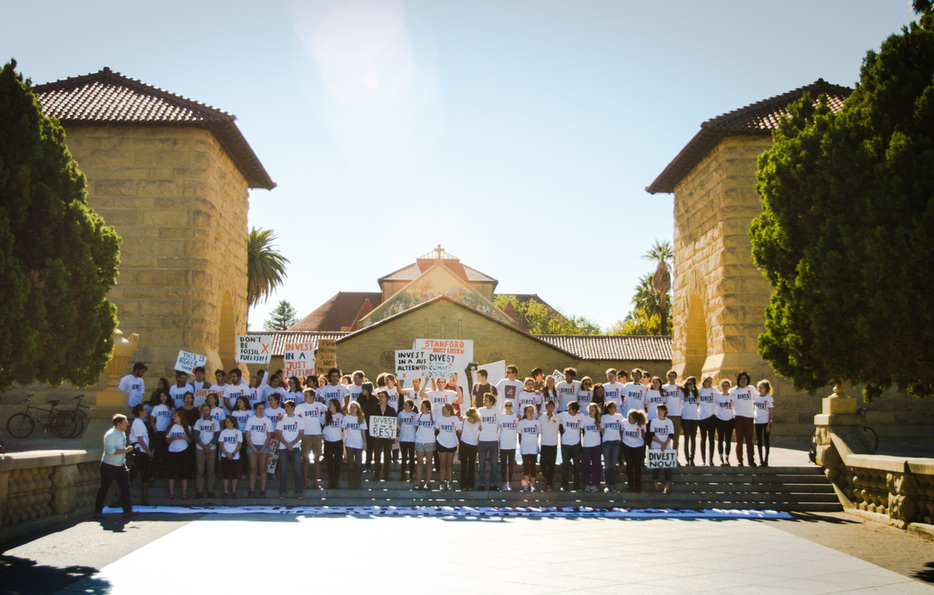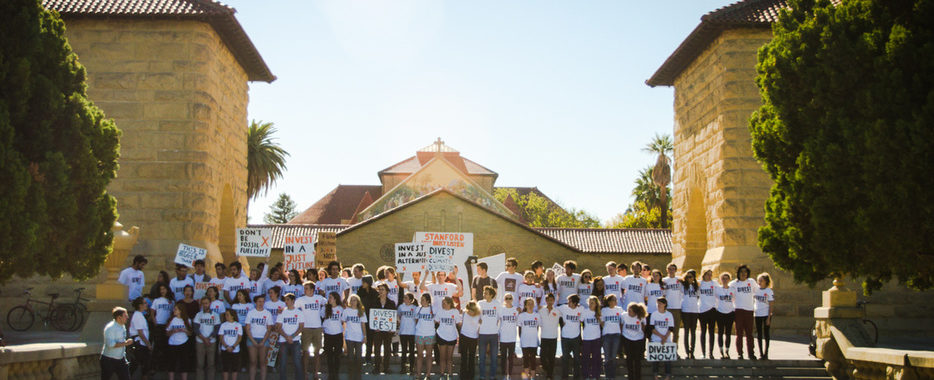How to show campus officials why they are wrong if they say no.
Divestment
Every great now and again the long term economic advantages of investing in an industry, and our collective understanding of the ethics involved in continuing to do so, come to a distinct crossroads.
Divesting, is one tool used in such circumstances, and is the process through which a group or organization pull their money out of potentially dangerous or socially harmful investments.
Past instances include divestment from many South African companies to combat state sponsored racism during apartheid, as well as many institutions divesting from tobacco companies in the 1990s to early 2000s as health concerns and lawsuits against tobacco companies reached a critical mass.
Many student-led groups and environmental organizations are now pushing for divestment from polluting fossil fuel industries under some of the same arguments: burning fossil fuels contributes negatively to human health and the health of our shared environment. People can experience cancer, asthma and heart attacks from pollution from fossil fuels from power plants and vehicle tailpipes.
Divesting on a national or even statewide scale can take decades or be nearly impossible with legislative red tape. However, on the local level great strides can be made.
California College Campaigns
California State University (CSU) Chico
In December of 2014, CSU Chico made national history by becoming the first public university to pledge to fully divest from the top 200 fossil fuel companies. The victory, culminating in an 8-4 vote by the University Foundation’s Board of Governors in favor of divestment, came about only after three semesters of planning, work, and activism by a group of students and their professor of a course called Environmental Thought and Action.
According to Kevin Killion, a California Student Sustainability Coalition leader and a CSU CSU Chicodivestment co-coordinator, their campaign can be divided into three different segments, with each being the primary focus of one semester’s work.
“The first semester was primarily information gathering and planning. Finding which documents we needed to fill out, where the fossil fuel money was being invested, and who we needed to convince, which our professor, ‘Dr. Mark,’ was incredibly helpful with,” Killion recalls.
Professor of Geography Mark Stemen’s course places a large emphasis on the environment and working with local communities. He said, “I was able to help by getting signatures from over 100 other faculty members on a petition to divest, as well helping the students to understand administrative policies and how to work to change them. Often this could be just as simple as pointing students to the right documents to fill out, or knowing who to email or call and where to start.”
During the next semester, students gathered signatures for petitions and put forth their measure to be included in the Associated Students student election, written such that a “yes” vote will direct student elected leaders to encourage CSU Chicoto fully divest. Students then took their message public, with large scale demonstrations around campus, including a “human oil spill,” and created a dramatic display from one of their largest buildings of a banner that said “DIVEST.”

Students Drop banners to spell out the word DIVEST. Photo from CSU Chico Geography and Planning Department
Students also set up social media campaigns, distributed orange square patches worn by students, and placed orange square signs all across campus as a symbol of the cause. Because of these efforts, 85% of students voted for CSU Chico to divest.
The third and final segment of the campaign involved lobbying and working with CSU Chico’s Foundation Board of Directors before they made their final vote on whether or not funds would be divested. Killion said, “It is important to maintain a respectful yet confident demeanor with administration.”
Direct action and activism can be useful tools for garnering student support and getting your groups voice heard, but after doing so, attempting to reach out and work together with board members can actually work.
By crafting thoughtful presentations to help inform the board of the inherent hypocrisy of investing in fossil fuels while claiming to be a university dedicated to sustainability, and by showing examples of other institutions’ successful divestments with little to no monetary loss, the students were able to persuade the board to fully divest.
Stanford University
In May of 2014, Stanford’s Board of Trustees voted to remove all of its investments from coal. This vote, passed by Stanford’s Board of Trustees happened on the back of years of work and organization by students, especially those with Fossil Free Stanford (FFS).
Started near the end of 2012, FFS formed with the goal of convincing Stanford to divest from all fossil fuel industries. After a writing a letter of intent, FFS held a march and a rally before they were able to speak with their school investment panel.

Fossil Free Stanford students, on a march to raise awareness of their cause. Photo from fossilfreestanford.org
They then submitted a request for review of fossil fuel investments on the grounds that such industries contribute massively to climate change which may cause dangerous and unforeseen consequences across the globe. “The system for review of investments was already there, which was really nice,” said John Ribiero-Broomhead, member of FFS.
Stanford had been a part of the previous South African Apartheid and tobacco divestment movements, so all the framework needed to start a fossil fuel divestment campaign could be found by looking to past work. The students gathered the required 1,000 signature petition in order to get a movement on the ballot for the student body to vote if in favor of, or against divestment. They then campaigned before student elections, leading to a 75% vote by students in favor of divestment.

Members of Fossil Free Stanford. Photo from fossilfreestanford.org
While the group took the news of the 2014 coal divestment as a huge win, they remained dedicated to fully divesting their school from all fossil fuels. Shortly following the coal divestment decision, FFS filed another request for review for Stanford’s remaining holdings in the natural gas and oil industries. However, a new addendum had been added to the divestment criteria between the coal decision and their next request for review.
This addendum states that industries must be examined to see if they provide a “net social benefit or net social harm,” before divestment can occur, and due to this addition their request for review was denied.
“In this instance Stanford is ignoring their own published research by climate scientists we have within our faculty,” Ribiero-Broomhead said, regarding the notion that oil and gas industries can possibly be viewed to be seen as causing more net good for society than harm.
After spending months attempting to speak with administration about getting their request re-evaluated and subsequently being ignored for months, FFS members and allies staged a nonviolent direct action sit-in event where they camped out in the main quad of the Stanford president’s office. Finally, at the end of the week long camp out, the Stanford’s president agreed to meet with FFS members.
“Nothing further was promised to be divested that day, but we didn’t see it as a failure, rather we all felt inspired to finally be able to once again have our voices heard, and our concerns responded to,” Ribiero-Broomhead said, describing the feelings of those present, “We are also still very hopeful.. Perhaps we won’t need to stage any more direct action events to finish our mission, but we will be ready to if we need to, and Fossil Free Stanford won’t stop until Stanford is fully divested from all fossil fuels.”
Butte College
Beginning in late 2016, students at Butte College formed a group dedicated to getting the campus fully divested from fossil fuels. Butte College has long claimed itself as a leader in sustainability, even offering a certificate in sustainability studies, held by yours truly. Yet when it comes to the matter of divestment, administration has so far failed to lead by example.
“We’re still in the formulation and outreach steps of our campaign, but our next step is going to be drafting a letter to the Butte College Board of Trustees, asking them to make their investments transparent, and to state our intent of getting any investments in the top 200 fossil fuel industries divested elsewhere,” said Courtney Copper, coordinator of the group, and CSSC member. “We’ve also been working with other organizations like the CSSC, Fossil Free UC, as well as working with former members of the CSU Chico divestment campaign.”
“I’m hopeful,” says Edward Fortenberry, another student working within the campaign when asked his thoughts on what a letter to the board might accomplish. “They seem to be entertaining the idea now,” he also responded regarding the Board of Trustees current attitude toward divestment.
The group is prepared to make plans of direct action events if necessary, hoping to raise awareness amongst the student body in a similar fashion to other campaigns. First though, “You start by talking, then you act,” according JT Abbott, another student member who is responsible for social media and outreach for the group.
“What we need most right now is more members and more people interested,” Copper said in closing, “And we want all types of people: artists, activists, researchers, and people from other organizations. There’s a place for everyone. We’re a small group right now but have hopes of growing much larger, and I for one am not leaving until I see Butte College divested.”
Start Small, Think Big, Act Responsibly, and Follow Through
One of the aspects that all of these campaigns have had in common is that they all started very small and grew into larger movements. The campaign to divest at Stanford, which successfully convinced the Board of Trustees to divest in coal, and continues on with Fossil Free Stanford, started very simply after a group of students heard Bill Mckibben speak one night and decided to meet for pizza after and continued talking about what they could do. The wildly successful CSU Chico campaign started with the work of one class, and eventually led to it being the first Public University in the US to fully divest from the fossil fuel industry. The Butte College group is currently only a small core of interested students with some support from other divestment organizations, but hopes to grow substantially in the coming semesters.
Another point mentioned by all these campaigns that is worth reiterating is to remember to act respectfully and responsibly. Passions can run very high in students when it comes to the areas of sustainable practices and divestment. This is especially true when there is often a generational and emotional gap between the students who will inherit the consequences of such investments, and the administration with an often rigid financial responsibility that favors safe returns over all else. The different direct action events mentioned throughout the article undoubtedly helped in raising awareness of their issues, but these actions came only after attempts to change things non-disruptively, and likely would have accomplished nothing without thorough follow through.
Final Thoughts
Our modern society and western ways of life are sadly, are almost completely intertwined to the present use of fossil fuels, but that does not mean our future has to be. Indeed it must not be, according to nearly unanimous scientific consensus. Which brings us to the final argument, articulated by all of the divestment campaigns mentioned: How can we, as rational beings, continue to invest in a catastrophically, environmentally destructive, industry that we know must be phased out if we want to continue living on a planet that even resembles what we all now call home?

